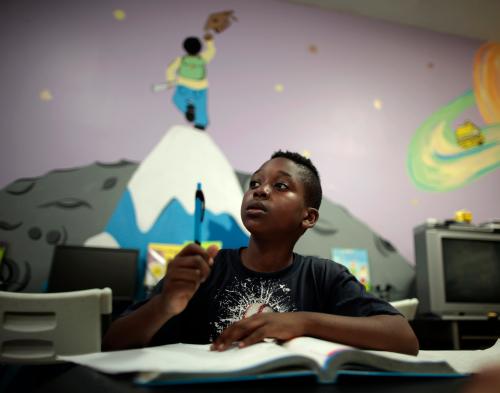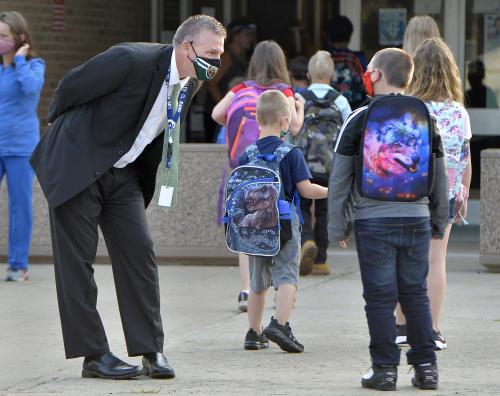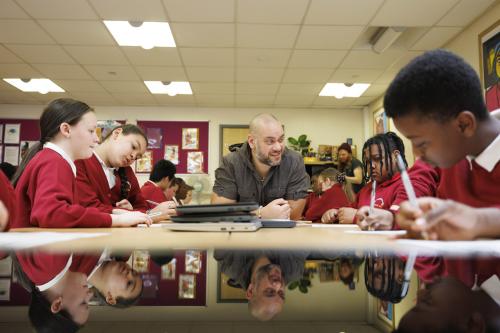In the fall of 2020, higher education institutions were faced with the decision of continuing traditional in-person classes or offering online instruction. Many schools quickly transitioned to Zoom classes, asynchronous lectures, and other methods of online instruction. In a new paper forthcoming in Applied Economics, two of us (Klinenberg and Startz) examine how financial and other characteristics of universities are associated with university decisions to reopen in person or online. Perhaps unsurprisingly, universities respond to many sources of pressure, and examination of their response to COVID-19 may help reveal more generally which pressures are important.
This paper breaks new ground by using data from the College Crisis Initiative (C2i) at Davidson College, where one of us (Eldridge) is enrolled as an undergraduate. C2i has played a major role in collecting a broad range of data as colleges and universities respond to COVID-19, ranging from collecting data on K-12 mode of instruction to tracking vaccine mandates at individual higher education institutions. While our interest here is in identifying the association between college reopening decisions and various college characteristics, C2i provides a dashboard where readers can specify college characteristics directly relevant to their own interests and examine reopening decisions. C2i undergraduates also prepared and wrote a number of research briefs.[1]
For this paper, C2i tracked the mode of instruction at 1,278 institutions based on their public announcements in August and September of 2020. Davidson undergraduates found, cleaned, and organized the data about reopening, classifying decisions into three categories: mostly/fully in person, hybrid, or mostly/fully online.
The authors combined the C2i data with the Integrated Postsecondary Education Data System (IPEDS), institutional data reported to the federal government. Most of the data from IPEDS was drawn from the 2017-2018 academic year, providing a good picture of a college’s operations before COVID-19 hit higher education institutions. Using these data, Klinenberg and Startz identified key factors associated with university reopening statuses and one factor that, perhaps surprisingly, had no such association. Three of the main findings are discussed below.
As is common, the results in the paper demonstrate associations which may or may not be causal because not all factors can be controlled for. For example, the results about the effect of political control could be picking up cultural factors that also explain political control (although regional location is controlled for, which somewhat mitigates such an issue). Nonetheless, to the extent that uncontrolled for factors would be largely unchanged in the future, the results here would still be predictive.
Finding 1: The varying sources of college revenues are associated with different reopening choices.
While numerous factors played into reopening decisions, the researchers found that sources of institutional revenue were strongly associated with reopening plans. Examples appear in the Figure 1 below, where the predicted probability of reopening in person is plotted on the y-axis against various financial variables. Predictions are separated for public and private institutions. (Figure 1 shows predicted probabilities controlling for a variety of other factors mentioned in the note to the figure predictions come from a multivariate logit regression.) Steep lines indicate the particular financial variable was strongly associated with reopening decisions, and flat lines indicate no association. In each panel, the horizontal span of the lines indicates the middle 95 percent of the data.
Tuition revenue is the financial gorilla for many universities, and reopening decisions could theoretically drive enrollment—and hence tuition revenue—either up or down. On the one hand, if , if enrollment dropped. On the other hand, students and their families might worry about catching COVID-19 and prefer online instruction (remember, this was pre-vaccine). Therefore, it is unclear whether we should expect universities that rely more on tuition revenue to be more or less inclined to open in person.
Empirically, it turns out that tuition revenue had a neutral association with college reopening decisions—perhaps because these two issues roughly balanced. Panel A in the graph below shows that schools with a higher percentage of tuition and fees in their core revenue were neither more nor less likely to open in person.
Nonresident (out-of-state or foreign student) tuition is an important source for many public universities because nonresident students are charged significantly higher tuition rates. In contrast, private universities generally charge uniform tuition rates. The fraction of students attending from out-of-state matters both if there are differential tuition rates and if student travel to attend school raises health concerns. For private universities, the number of nonresident students had no association, suggesting divergent reopening decisions by college sector.
The story with respect to auxiliary revenue is quite different from the tuition story. When institutions charge students for tuition, there are additional costs, such as room and board, meal plans, and athletics ticket sales. Such auxiliary revenue relies largely on school being in person. If a school were to operate remotely, it would not receive these additional revenues. Institutions with a higher dependency on these auxiliary services saw a higher empirical likelihood of operating in person. Panel C in the figure shows the relation. For both public and private institutions, high levels of auxiliary revenue were associated with a higher probability of reopening in person, in fact with a surprisingly higher in-person reopening probability.
Auxiliary services differ from most core services at the university in one important aspect—if students are not in residence, then some costs can be cut. While few universities planned to lay off faculty, it would be easier to reduce staffing in unoccupied dorms, unused dining halls, and empty stadiums, allowing at least some savings if moving online. Panel D shows that private schools where auxiliary wages and salaries were important were indeed less likely to reopen in person. The direction of the change for public universities was the opposite, possibly because public universities are subject to more outside pressure about layoffs during a crisis. For both private and public schools, the associations were fairly small because the amount that could potentially be cut was fairly small.
Finding 2: Public and Private universities reacted differently
The authors found several further differences in the reopening decisions of public and private institutions, in addition to those discussed above. As local deaths per million (tracked by the New York Times) increased, private schools were less likely to open in person. However, the local COVID-19 cases surrounding public schools showed almost no change in the probability of opening in person. It is unclear exactly why this is; some might argue that state-level political decisions might have been prioritized over adapting to individual community case counts.
Interestingly, private historically Black colleges and universities (HBCUs)—which historically place great emphasis on college community and personal interactions—were much more likely to move to an online format. (Similarly, Gilbert et al. (2020) finds a preference among Black parents for online instruction in K-12.) For public HBCUs, estimates were too imprecise to know whether there was an association.
Finding 3: State political leanings matter
The authors incorporated data on political leanings at the state levelRepublican control was associated with a six percent higher probability of opening in person, as compared to Democratic or divided control. Similarly, Felson and Adamczyk (2020) found that states that voted for Donald Trump in the 2016 election were more likely to open in person. Hartney and Finger (2022) came to this same conclusion when inspecting K-12 school districts’ reopening plans as well, finding little connection between the severity of the virus and reopening plans. Political leanings apparently hold a major stake in instruction mode.
Moving Forward
In summary, we find suggestive evidence that institutional decision-making was informed by financial incentives in the fall of 2020. When schools, particularly private schools, derived a larger percentage of their core revenue from auxiliary services, the financial burden of operating online may have seemed too risky. Political influences also may have shaped public institutions’ instructional modes, with more in-person instruction in states controlled by Republicans. As the school year developed and vaccines rolled out, schools again had to make a difficult choice to reassess and determine their future operation mode, some incorporating these online systems and some leaving them in the past.
C2i continued to track the link between covid and college decision-making through 2021 and has produced several useful insights based on their analyses. For example, about two thirds of colleges recommended or required student vaccinations, and colleges with low student-to-faculty ratios were much more likely to require student vaccination. As another example, C2i found strong regional differences in masking policies at football games. Even though the emergency phase of the pandemic has passed, the C2i data and lessons derived from it can still be useful to both understand how institutions responded and what can be done now to build a more resilient future.
The full paper is forthcoming in Applied Economics.
Footnotes:
[1] As an aside of interest to our higher education readers, the C2i project is something of a model for actively involving undergraduates in research. Dozens of Davidson College undergraduates engaged in tasks ranging across data collection, communications, and project management. For example, the first author here was responsible for initial drafts of this Chalkboard piece. (Back to top)








Commentary
Financial, political motives explain colleges’ COVID-19 reopening decisions
September 27, 2022